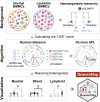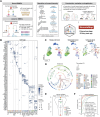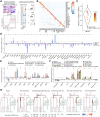Resolving Leukemia Heterogeneity and Lineage Aberrations with HematoMap
- PMID: 39945785
- PMCID: PMC12343003
- DOI: 10.1093/gpbjnl/qzaf005
Resolving Leukemia Heterogeneity and Lineage Aberrations with HematoMap
Abstract
Precise mapping of leukemic cells onto the known hematopoietic hierarchy is important for understanding the cell-of-origin and mechanisms underlying disease initiation and development. However, this task remains challenging because of the high interpatient and intrapatient heterogeneity of leukemia cell clones as well as the differences that exist between leukemic and normal hematopoietic cells. Using single-cell RNA sequencing (scRNA-seq) data with a curated clustering approach, we constructed a comprehensive reference hierarchy of normal hematopoiesis. This reference hierarchy was accomplished through multistep clustering and annotating over 100,000 bone marrow mononuclear cells derived from 25 healthy donors. We further employed the cosine distance algorithm to develop a likelihood score to determine the similarities of leukemic cells to their putative normal counterparts. Using our scoring strategies, we mapped the cells of acute myeloid leukemia (AML) and B cell precursor acute lymphoblastic leukemia (BCP-ALL) samples to their corresponding counterparts. The reference hierarchy also facilitated bulk RNA sequencing (RNA-seq) analysis, enabling the development of a least absolute shrinkage and selection operator (LASSO) score model to reveal subtle differences in lineage aberrancy within AML or BCP-ALL patients. To facilitate interpretation and application, we established an R-based package (HematoMap) that offers a fast, convenient, and user-friendly tool for identifying and visualizing lineage aberrations in leukemia from scRNA-seq and bulk RNA-seq data. Our tool provides curated resources and data analytics for understanding leukemogenesis, with the potential to enhance leukemia risk stratification and personalized treatments. The HematoMap is available at https://github.com/NRCTM-bioinfo/HematoMap.
Keywords: Acute leukemia; Bioinformatics; Hematopoietic hierarchy; Lineage aberration; Single-cell RNA sequencing.
© The Author(s) 2025. Published by Oxford University Press and Science Press on behalf of the Beijing Institute of Genomics, Chinese Academy of Sciences / China National Center for Bioinformation and Genetics Society of China.
Conflict of interest statement
The authors have declared no competing interests.
Figures






Similar articles
-
Prescription of Controlled Substances: Benefits and Risks.2025 Jul 6. In: StatPearls [Internet]. Treasure Island (FL): StatPearls Publishing; 2025 Jan–. 2025 Jul 6. In: StatPearls [Internet]. Treasure Island (FL): StatPearls Publishing; 2025 Jan–. PMID: 30726003 Free Books & Documents.
-
Systemic pharmacological treatments for chronic plaque psoriasis: a network meta-analysis.Cochrane Database Syst Rev. 2021 Apr 19;4(4):CD011535. doi: 10.1002/14651858.CD011535.pub4. Cochrane Database Syst Rev. 2021. Update in: Cochrane Database Syst Rev. 2022 May 23;5:CD011535. doi: 10.1002/14651858.CD011535.pub5. PMID: 33871055 Free PMC article. Updated.
-
Systemic pharmacological treatments for chronic plaque psoriasis: a network meta-analysis.Cochrane Database Syst Rev. 2020 Jan 9;1(1):CD011535. doi: 10.1002/14651858.CD011535.pub3. Cochrane Database Syst Rev. 2020. Update in: Cochrane Database Syst Rev. 2021 Apr 19;4:CD011535. doi: 10.1002/14651858.CD011535.pub4. PMID: 31917873 Free PMC article. Updated.
-
Surgical interventions for treating intracapsular hip fractures in older adults: a network meta-analysis.Cochrane Database Syst Rev. 2022 Feb 14;2(2):CD013404. doi: 10.1002/14651858.CD013404.pub2. Cochrane Database Syst Rev. 2022. PMID: 35156192 Free PMC article.
-
Signs and symptoms to determine if a patient presenting in primary care or hospital outpatient settings has COVID-19.Cochrane Database Syst Rev. 2022 May 20;5(5):CD013665. doi: 10.1002/14651858.CD013665.pub3. Cochrane Database Syst Rev. 2022. PMID: 35593186 Free PMC article.
Cited by
-
Biomedical Big Data and Artificial Intelligence in Blood.Genomics Proteomics Bioinformatics. 2025 May 30;23(2):qzaf043. doi: 10.1093/gpbjnl/qzaf043. Genomics Proteomics Bioinformatics. 2025. PMID: 40314993 Free PMC article. No abstract available.
References
-
- Shafat MS, Oellerich T, Mohr S, Robinson SD, Edwards DR, Marlein CR, et al. Leukemic blasts program bone marrow adipocytes to generate a protumoral microenvironment. Blood 2017;129:1320–32. - PubMed
-
- Arber DA, Orazi A, Hasserjian R, Thiele J, Borowitz MJ, Le Beau MM, et al. The 2016 revision to the World Health Organization classification of myeloid neoplasms and acute leukemia. Blood 2016;127:2391–405. - PubMed
-
- Pagliaro L, Chen SJ, Herranz D, Mecucci C, Harrison CJ, Mullighan CG, et al. Acute lymphoblastic leukaemia. Nat Rev Dis Primers 2024;10:41. - PubMed
LinkOut - more resources
Full Text Sources

